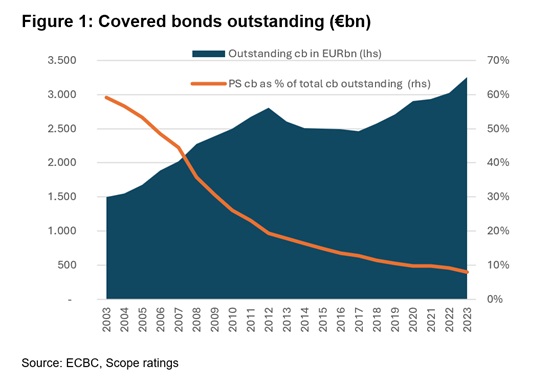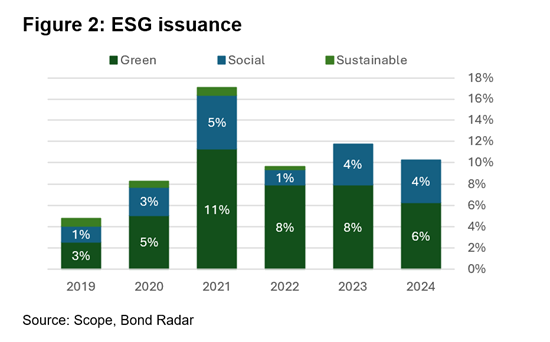Announcements
Drinks

What Frederick the Great might have told Mario Draghi about covered bonds
By Mathias Pleissner, Covered Bonds
The report emphasises the urgency of structural reforms to bolster Europe’s growth and reverse its stagnating productivity. It estimates additional annual investment needs of around EUR 750bn-EUR 800bn, or about 4.5% of EU-27 GDP. While the role of securitisation was discussed, the report is notably silent on the contribution covered bonds could make.
If Frederick the Great could talk to Mario Draghi about his report, he might have had some thoughts about how covered bonds could help to address the investment gap.
First area of action: the innovation gap
Covered bonds can offer valuable funding support to address Mario Draghi’s first area for action: the innovation gap between Europe and the US and China. European Secured Notes (ESNs), introduced as part of the capital markets union project could, from a macro perspective, offer funding benefits to banks and SMEs, which form the backbone of the European economy.
ESNs can bolster financing for research and innovation (R&I). They will not, however, allow banks to increase the volume of SME financing if risk weights for SME portfolios increase and tie up capital. This compares unfavourably to securitisations, which can be used to free up capital and increase banks’ SMEs lending capacity.
Classic European (Premium) covered bonds can also provide value. While alternative collateral is ineligible according to Article 129(1) of the Covered Bond Directive, exposures to or guaranteed by central governments, central banks, multilateral development banks, or international organisations that qualify for credit quality step one, do qualify for European premium covered bonds.
Using public sector-guaranteed collateral could boost public sector covered bonds, which have fallen somewhat from grace: the share of public-sector covered bonds has fallen to single digits compared to almost 60% in the early 2000s.

We have observed an increasing use of export credit-guaranteed corporate loans in public sector covered bonds. These instruments transfer part of the risk of payment default to sovereigns via their export credit agencies and are designed to promote foreign trade. Another example is the use of credit guarantee schemes to protect SMEs from COVID-19 impacts, which are emerging in some European covered bonds.
In the US, loans granted to SMEs via the US Small Business Administration (SBA) offer another proven example. The SBA, an independent government agency, provides support to entrepreneurs and small businesses through SBA (7a) loans, which are extended via banks, credit unions and other lenders. The SBA provides a government-backed guarantee on the majority of the loan, leaving some “skin in the game” for originators. In the past, we have seen these loans in public sector cover pools.
We believe that if adequately structured to meet eligibility criteria, a similar set-up sponsored by the EU, development banks, agencies or by individual sovereigns could become a blueprint for sponsoring SMEs and R&I investment via (Premium) Covered Bonds.
Banks as intermediaries could benefit from low capital requirements for these loans, boosting their lending capacity while maintaining their role as points of contact and originators. There have already been several SME initiatives and transactions sponsored by European agencies where risk has been shared. Adding covered bonds would not only allow for lower risk weights but also provide SMEs with lower funding costs.
The second area for action - decarbonisation and competitiveness
On Draghi’s second focal point, we make a similar case as for innovation. Decarbonisation can be promoted through guarantees allowing for credit growth due to banks’ minimal capital requirements plus affordable funding via covered bonds.
Covered bonds are already adding to decarbonisation by refinancing sustainable collateral. Green covered bonds are still a niche within banks’ total funding, but they add funding and investor diversification, providing a stabilising element in a bank’s funding mix.
Direct incentives for issuing green covered bonds are low – for now. To the extent that there are any funding advantages in the form of a greenium, these are limited to less than 5bp. But at the same time the investor base and therefore the order books for green issues tend to be bigger. We believe this trend will grow. Large, globally active issuers will, over time, have no alternative to becoming active environmental or social labelled covered bond issuers.
Year-to-date, green covered bond activity is low at 6% of new issuance. This year has the potential to outperform 2023 and 2022 as Q4 green issuance is typically strong. The breakthrough has been a long time coming but could be fostered by political promotion, too.
The third area of action: increasing security and reducing dependencies
It might be presumptuous to claim that covered bonds add to Draghi’s third area of action: increasing security and reducing dependencies. While covered bonds will not prevent war or provide significant military financing (even though there is anecdotal evidence of some military funding in public sector cover pools), they do provide financial stability.
Because the covered bond is a European product mainly used by European issuers. Its strength not only lies in the dual-recourse mechanism but mainly in its strong governance support. With that, Europe already has a strong and stable financial instrument that provides banks in Europe with refinancing sourced mainly from Europe. This provides independence against political and macroeconomic influences and support to Europe’s sovereignty.
The European covered bond is a proven product that can be broadened with little need for amendments or softening of standards. Unlike other financial instruments, it has proven itself to be an evergreen issued and traded instrument, even in stressed economic environments. Covered bonds do not benefit just from dual recourse but also from a super senior position in the capital structure, benefiting from a strong regulatory and legislative framework that together allow for the highest ratings.
European (Premium) covered bonds could support funding to address key areas of action highlighted by the Draghi report. However, this will only work, if issuers play an intermediate role without taking on the entire capital burden. Without EU promotion and burden-sharing, it will remain challenging to motivate market participants to fund these goals.
Stay up to date with Scope’s ratings and research by signing up to our newsletters across credit, ESG and funds. Click here to register.







